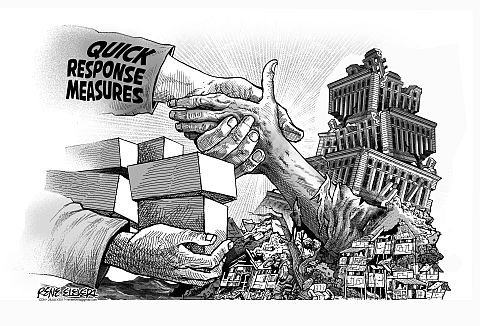
President Rodrigo Duterte’s call on Congress to create a new agency or department that would be “responsive and empowered to deal with changing and prevailing 21st century conditions and deliver enhanced disaster resiliency and quick response measures” was followed by his question on the stability of the aging Batasang Pambansa building where he delivered last Monday’s State of the Nation (Sona) address to Congress.
“I am wondering, is this building secure? Is there a sinkhole below?” the President asked before wisecracking that he hoped there won’t be an earthquake during his televised address to lawmakers and the public.
But the President’s moment of levity doesn’t mask nor downplay the seriousness and urgency with which he made the call since it came days after the July 6 earthquake that shook Jaro town in Leyte province and damaged power plants and lines and rattled the nerves of Metro Cebu residents.
It was no small coincidence that Science and Technology Undersecretary Renato Solidum Jr., who is also concurrent director of the Philippine Institute of Volcanology and Seismology (Phivolcs), visited Cebu to meet with disaster management and response chiefs in Metro Cebu and the province two days after the President made the call to Congress.
Solidum’s disclosure of Cebu’s fault lines which cut across six cities and 11 towns to local media was informing and a bit disconcerting. He said Cebu, like Bohol before it got hit by the 7.2 magnitude earthquake in Oct. 15, 2013, had never experienced an earthquake for 400 years.
Solidum also said if Cebu did experience an earthquake it would be within the Intensity 8 range which, considering how a lot of Cebu residents panicked over last July 6’s tremors caused by the Jaro town quake, would be disastrous and devastating.
This is where Cebu’s local officials should be concerned about especially in Cebu City which is listed among the six cities lying within the fault lines.
The 2013 quake in Bohol damaged the old Basilica building in downtown Cebu City, so one can only imagine how much more damage would be inflicted in case of an actual quake in Cebu itself.
It’s not about being alarmist because one cannot never predict when the actual “Big One” will occur in Cebu, and it’s not alone since the country itself lies within the Pacific Ring of Fire where seismic movements would likely occur in the 21st century.
While Congress takes its time to craft an agency that would respond and deal with calamities, local governments in Cebu should be at the forefront in actively involving their communities to prepare for emergency quick response measures to mitigate the impact of quakes and super typhoons.
And building officials should now take their work more seriously and evaluate the stability of both new and aging buildings as well as homes in Metro Cebu before it’s too late.